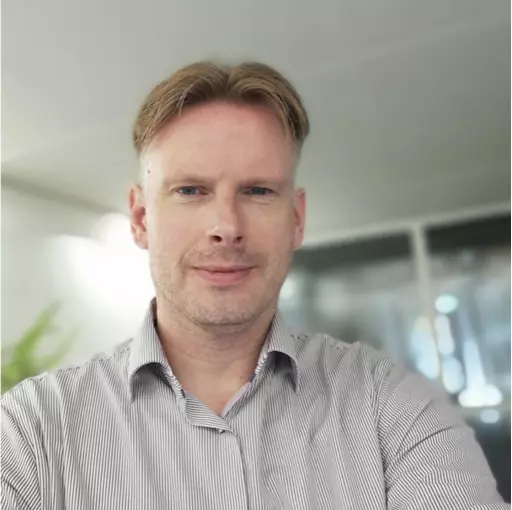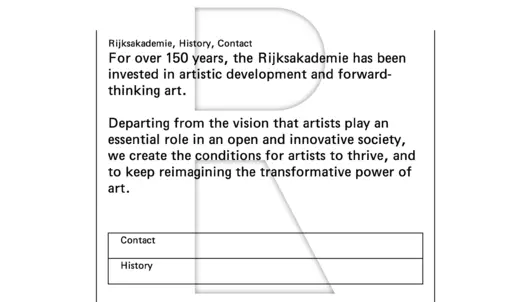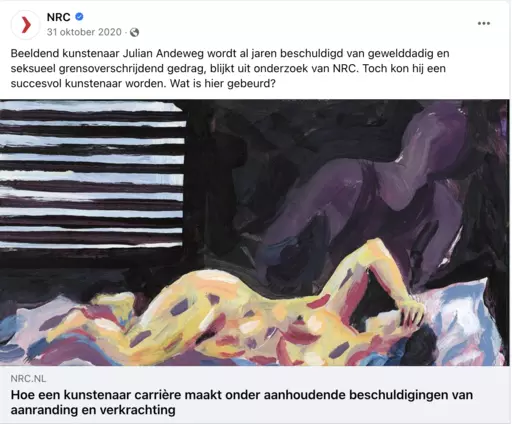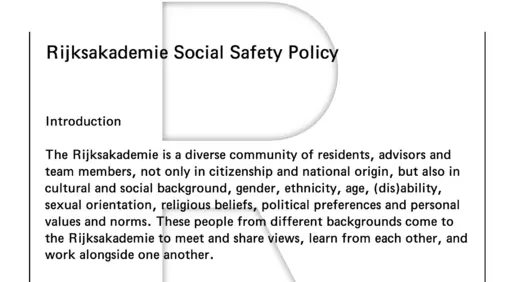
Niels Andree Wiltens

Niels Andree Wiltens
Niels Andree Wiltens is the social safety officer in the HR department at the Rijksakademie, a post-academic artistic institution in Amsterdam, the Netherlands. Niels has been joining a series of arts educator workgroups organised by Platform BK and the artist Falke Pisano from 2020-2022.
Niels Andree Wiltens is the social safety officer in the HR department at the Rijksakademie, a post-academic artistic institution in Amsterdam, the Netherlands. Niels has been joining a series of arts educator workgroups organised by Platform BK and the artist Falke Pisano from 2020-2022.
SA: The Rijksakademie is a different kind of institution than the educational academies that most of us are working in. I think a distinction can be made between the residency model of the Rijksakademie, with professional artists who have worked already some years outside of the academy setting, and teaching models with people who are 18 years old, at an undergraduate level. To a certain extent, this brings a different set of responsibilities.

WEBSITE:
NAW: Well, we suddenly ended up on the front page of the Dutch newspaper NRC (October 31, 2020), reporting on very serious allegations with regard to a former resident.. That turned up a lot of things that artists and team members who had been working with him were experiencing. And at that time, we had a new director, who was coming from the UK, and for her it was normal that there would be a Code of Conduct. She was very surprised that there wasn’t one here, and so she was the one who instigated getting a Code of Conduct and made sure that we got it.
SA: So, previously there was not one at all?
NAW: No, not at all, so the new director asked a law firm that specialises in this topic to draft up a Code of Conduct which then had to be re-written to fit the Rijksakademie culture. So, there was a lot of making it fit our needs and what we needed it to say, and this resulted in the document that we have now. Thankfully, we have not had to use it but it is very good to have, especially when reaching out to artists who may be applying to the Rijksakademie. For them those things are important. This is also why I now fulfil the social safety role now, so that there is clearly defined person and office to go to address social safety issues.
SA: It’s interesting that it was prepared by a legal firm. I think you can see it in the document, in terms of language and structure. It’s very legalistic and it deals with very clear procedural boundaries for behaviour and types of events.
NAW: Yes, in a way this is good. If we had to draw it up ourselves, it would be a very long process. The downside is that while there are some colleagues who say we should have an event where we launch and sign this document. Some critique that idea as just a celebration of this law firm’s work.
SA: Who was involved in the conversation of re-shaping it? Was that a management process or did it involve other actors?
NAW: That was a management process, led by the new director and two other persons in management. One of these has been here already for 25 years and is really the guardian of the culture. She has a good understanding what goes on inside the artist community of Rijksakademie. The other is involved with strategy and financial development, so she is looking at what we can tell sponsors about what is happening. The Rijksakademie needs to be attractive in different ways for different groups. These influences and interests came together and it shone a bright light on what we wanted the Code of Conduct to be for different stakeholders.
Something that we discovered along the way is that most problems happen outside the Rijksakademie building itself. So, it is a big step for us to drag the problem inside the Rijksakademie and start using a Code of Conduct. For example, if our artists go to parties together and something happens, what responsibility do we legitimately have there?
SA: Is it legally possible to take a position on cases that happen between Rijksakademie participants outside of the academy space?
NAW: Well, that is very difficult. We have a duty of care towards our participants. A formal duty of care stemming from our status as an ‘erkend referent’ with the IND. But it is hard to draw a line where that duty of care starts and ends. We also very much want to have the same duty of care towards all artists, even if they have been living in Amsterdam for the past 30 years and their resident’s permit is not dependent on the Rijks. So, this is something that makes it a bit complicated to use a Code of Conduct and create rules for everybody inside the organisation, even though people want this.
SA: In the document, it seems that there are no distinctions made between roles. It aims to cover everyone equally?
NAW: Yes, basically everyone who sets foot on our terrain is covered.
SA: It is an interesting problem, this one, which again is different for school type academies, where there are quite clear teacher-student relationships. It may be more ambiguous when a participant is 40 years old and a supervisor is 35 years old. There is a different power dynamic.
You said that part of the intention is that prospective residents can see that there are measures in place. How would they see this document? Is it part of the publicity material that they can see when they are applying?
NAW: It is on our website, and when we have interviews with prospective residents, it is brought up. When you become an advisor, you have one on one meetings with the artists. Then they have to know that we have a Code of Conduct. They will have received it, and our regular advisors have all read the document.
From now on, every contract states that if you sign, you also agree to our Code of Conduct.
SA: This document is very focused on legal definitions, and it refers to specific legal codes and differences between wrong doing, abuse, harassment and so on, as distinct legal categories. Do you expect to review this Code in the future to accommodate any changes that may happen in the law?
NAW: Yes, that is a big part of this whole process. Regular review is part of it, whether that is every two years, when something happens, or when there is a change in the law.
SA: Are there any things that you would like to share that you thought were particularly interesting in this gap between the legal document and how people apply it, or the perception of trying to apply it?
NAW: When we had an internal review after the Andeweg case, nobody had any complaints about any of the team members themselves. That caused a great relief of course, but also made that not everybody felt that it was important to have this conversation. Consequently, in my role as social safety officer I have to constantly explain why I am there. I can do that with a joke and not push myself in people’s faces, but having a good, organic role for the social safety officer is crucial. A lot depends on the person who is fulfilling that role.
SA: The Code specifies that there are two confidentiality advisors. Can you explain how they are contracted or appointed?
NAW: They come from the network that our directors have. One has a background in cases of discrimination and the rights of the handicapped. We felt it was important to have someone with that background because we suspected we had blind spots and were excluding people. So, we created a position for two confidentiality advisors, and until now this has worked very well. Each brings their own specialisation.
One of their tasks is to send a report to the institution once a year. We have also asked them to do workshops. We had an unconscious bias workshop already. These workshops give everyone an opportunity to get to know the confidentiality advisors in an informal way, while there is not an emergency going on. We intend to find a way to introduce them to the residents each year, so the residents know who they are, what they are, and when and how to contact them.
We have a booklet that we prepare each year, a ‘who is who.’ Everyone looks through that book at the beginning of the year, to see the photos and learn the names, and so it just helps to put their face in there. If you are in a vulnerable psychological state after something has happened, it may make it much more procedurally straightforward and approachable to go to them if their faces are already familiar.

WEBSITE:
Hoe een kunstenaar carriere maakt onder aanhoudende beschuldigingen van aanranding en verkrachting NRC 30 Oktober 2020.
The original (Dutch) article can be found here
